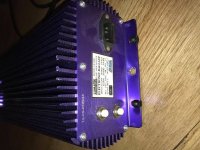Cosmic~guy
Member
I just got a 220v 1000w hps bulb and it came with a ballast Lk1000 dimeable electronic ballast that says input 120v and 240v? Does this mean I could plug the 220v end of the hood into the ballast and connect the ballast into a regular 110v outlet? It will just draw higher amps 9 vs 5a?





